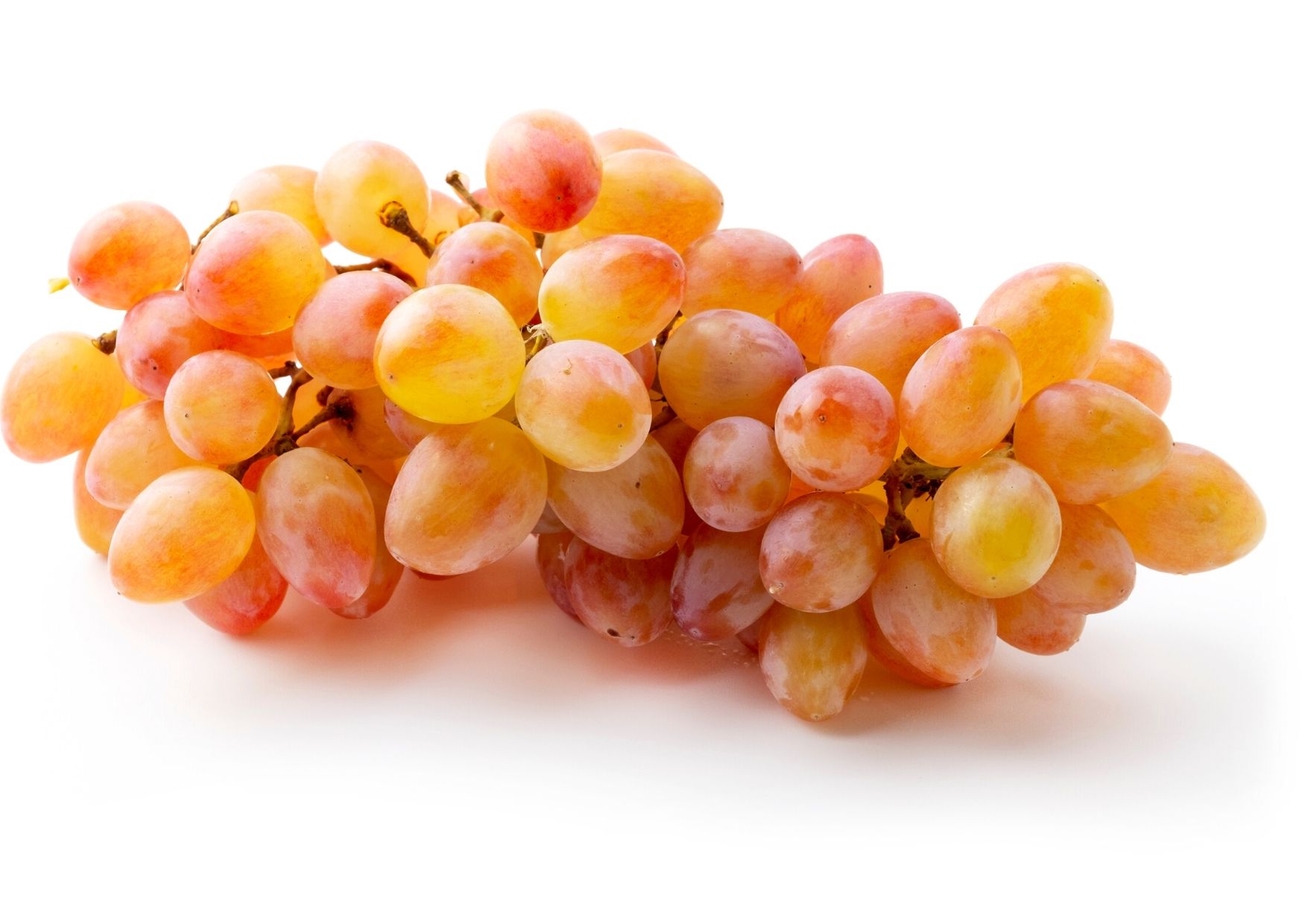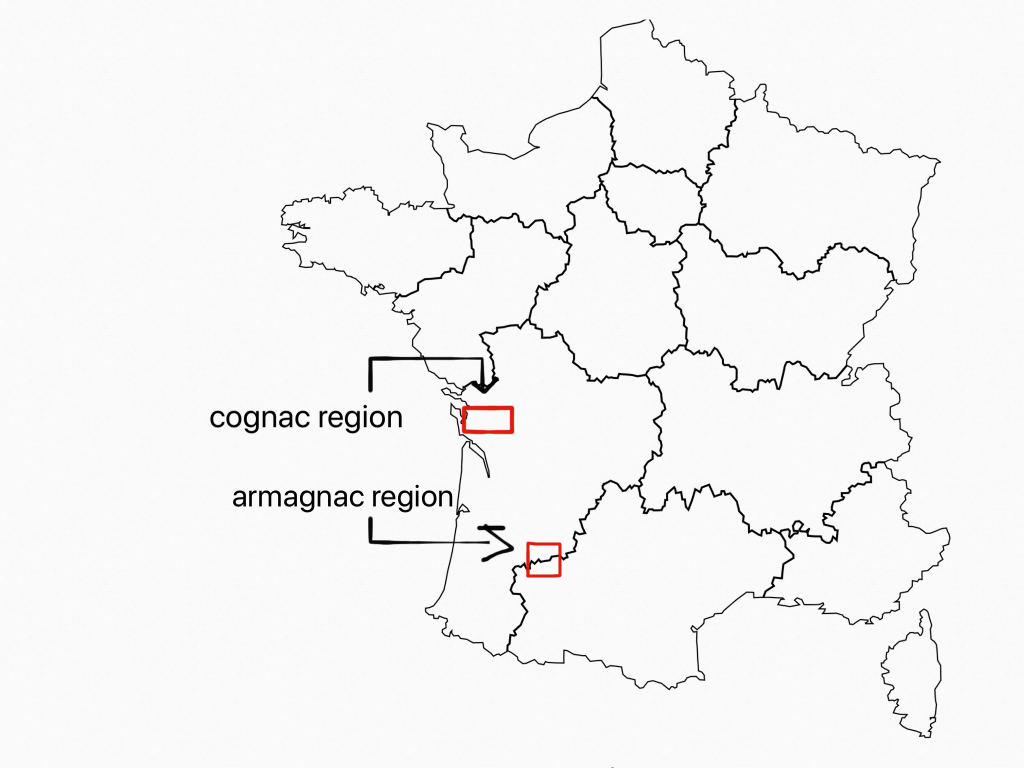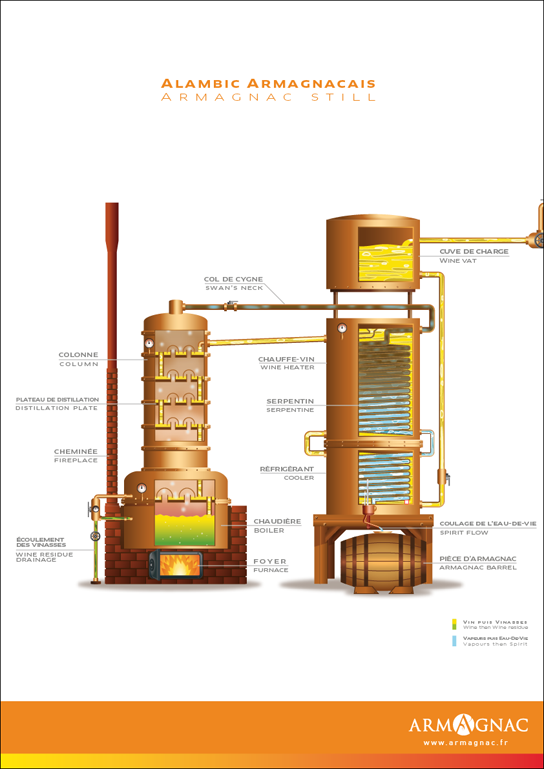
All you need to know about
Armagnac
in 10 minutes
Armagnac is a brandy (=wine distillate) made in southwestern of France, south East from Bordeaux.
The geography and the history of Armagnac
The Armagnac terroir covers part of Gascony between Garonne, Pyrenees and Landes. The climate brings contrasting influences, oceanic in the west and continental in the east. The vines thus benefit from almost constant mild weather at day, chilling winds at night, and moderate rainfall, which is very favourable to a slow ripening of the grapes.

Armagnac is one of the oldest French brandy, it is already mentioned in writings back in 1310. It may be because of the proximity to the Spanish border that the wine makers in this region early learned the methods of distillation from the Moors who ruled Spain during the middle ages.
It had decades of fame but has been, specially because of its geography (too secluded) overshadowed by its northern neighbor Cognac. It is quite hard to read anything about Armagnac without Cognac to be mentioned, whereas many Cognac books never bother to mention Armagnac. This is unfair and this is the reason why we leave this page to Armagnac only, which does not need to be define against but for itself.
Regulations
The Armagnac Appellation is divided into three areas:
* Armagnac-Ténarèze
* Bas-Armagnac
* Haut-Armagnac
Wines from each of these regions are distilled and aged separately. However, some Armagnacs are also blended from brandy made from wines form two or all three sub-regions.
Here are some other rules (non exhaustive):
* Armagnac comes from a plot of vines cultivated in a specific way on the appropriate terroir.
* Armagnac is distilled using a traditional alambic.
* Distillation must be completed no later than 31st March of the year following the harvest.
* Armagnac is aged in appropriate cellars where the ageing conditions (quality of the oak, capacity of the containers, buildings, aeration…) are controlled by the Bureau National Interprofessionel de l’Armagnac .
* Armagnac is quality controlled in the first year of ageing, in order to separate any eaux-de-vie that do not deserve the Appellation.
How is Armagnac made?
Which grapes varieties are used in the Armagnac production?
The varieties used are :
* Ugni Blanc: 20 % of the planting. Also known as Trebbiano, it gives acidic and low alcohol wines. This variety is well adapted to all of the Armagnac terroirs.
* Folle Blanche: 2% of the planting. primary variety used before the phylloxera crisis, abandoned for its sensitivity to grey rot after grafting. Folle Blanche is not favoured for young Armagnacs as it really only comes into its own when aged for at least 15 years. With this level of maturity it shows great finesse with characteristic floral aromas and flavours to the blend. But this is the only grape permitted to be used to make unaged Blanche Armagnac.
* Colombard: Suited to early harvesting and the making of young Armagnac, Colombard brings herbal, hay, and sometimes fruity and spicy aromas to Armagnac.
* Baco: 30% of the planting. Baco makes Armagnac unique since the 19th century. See below for details.
* Clairette de Gascogne, Jurançon blanc, Plant de graisse, Meslier Saint François or Mauzac blanc and rosé are all old varieties that are cultivated on few hectares of vines even though certain ones are being replanted by some producers that wish to preserve the heritage and historic diversity of Armagnac.
The Black Baco was conceived at the beginning of the 20th century as a solution to phylloxera. It is a cross between an American grape variety (Vitis Riparia, Noah) and a French grape variety, Folle Blanche. The decline of the black Baco began in the 1930s with the birth of the AOC. It was considered that it produced wines that were blank and foxy. Moreover, it has been discovered that wines from hybrids may have some methanol.In the 1950s, a European decree forbids the use of hybrids. Only a few old vines remain like Baco only white Baco also named Baco 22 continues to be authorised in the Armagnac AOC.
The fermentation process for Armagnac
The fermentation consists in making wine first. The base wine is acidic and low in alcohol. At the time they are to be distilled, wines must have a minimum alcoholic degree of 7% and a maximum alcoholic degree of 12%.
The distillation process for Armagnac
The wine must be distilled by the end of March following the harvesting of the grapes.
Most of Armagnac (about 95%) is obtained using a traditional continuous Armagnac alambic. It is a pure copper apparatus adapted, modified, improved by the region’s distillers over centuries.

Maturation and ageing of Armagnac
When distillation is complete, what will become Armagnac is put into new 400 litre oak barrels named pièces. Barrels can come from many different forests but barrels from the Monlezun forest are the traditional choice (the forrest is very conveniently nearby). The black oak from the Monlezun forest is known for the high tannin content, which enhances the stronger flavor, darker color and overall smoothness of Armagnac. The barrels do not have to be new, even though it is often the case, and the cellar master will have to adapt the time the Eaux-de-Vies will spend in the barrel according to the age of the barrel. Six months in a new barrel is often sufficient whereas the Eaux-de-Vies can stay up to two years into a barrel that has been used once already.These pièces are stored in the cellars where temperature and humidity are carefully monitored. High humidity is indeed essential. It used to be in humid cellars, in temperature controlled cellars, the casks are often sprayed to keep the humidity level high.
The styles of Armagnac
Armagnac styles according to age
Age statements on Armagnac labels refer to the youngest Eau-de-Vie in the blend and the following recognised terms are in used:
* V.S. or *** – Must be at least one-year-old (since 2013) and two years if exported.
* V.S.O.P. – Must be at least four-years-old.
* X.O. & Napoléon – Must be at least six-years-old.* Hors d’Âge – Must be ten years or older.
* Vintage – An age statement from a single year. This may be from a single cask or a blend of casks from different producers but all the Armagnac in the blend must have been harvested in the stated year.
FYI: Recently unaged Armagnac has been released (Is this still Armagnac though??). It consists of a clear spirits, bottled from the still. The new appellation is named Blanche d’Armagnac and must be made from Baco, Folle Blanche and Ugni Blanc. It reminds of Pisco.
Armagnac styles according to terroir
Bas Armagac
Soils: The vines grow on poor and acidic clay loam soils with pockets of iron elements in places that colour it reddish brown, hence their name “tawny sands”.
The “boulbènes”, characteristic sediment in the region are predominantly silty soils.
Style: The Armagnac from that region have a reputation of being elegant, light and fruity with a characteristic scent of ripe plums.
Production: This sub appellation forms 57% of the production. Bas-Armagnac’s main city is Eauze, home to the Bureau National Interprofessionel de l’Armagnac (BNIA) which oversees Armagnac production and marketing.
Tenereze
Soils: The land is criss-crossed by small streams and the sandy clay/limestone, chalky soils. Here we find “boulbènes” and “terreforts” (Gascon name given to clay-limestone soils that are heavy yet fertile).
Style: The Armagnac from that region have a reputation of robust with earthy flavours, which benefit from prolonged ageing, releasing a distinctive violet floral note.
Production: This sub appellation forms 40% of Armagnac’s vineyards.
Haut Armagnac
Soils: The predominantly chalky soil with areas of clay/limestone generally produces the least distinctive Armagnac. The hills are of limestone and clay-limestone whilst the valleys are sometimes covered with boulbènes. The vineyards here are quite sparse.
Style: The Armagnac from that region have a reputation of being sturdy.
Production: This sub appellation forms only 3% of Armagnac’s vineyards. This is explained by the fact that 104 of the original 230 villages were removed from the Armagnac appellation area in 2005.
RESOURCES/SOURCES
The Drunken Botanist, Amy Stewart
Alcools, André Dominé
Distilled Knowledge, Dave Broom
Distilled, Harrisson and Ridley
Out of the Jar, Gestalten Verlag
The fantastic website of BNIC
Wikipedia

